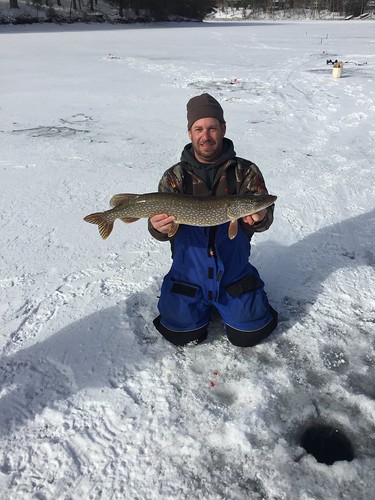Maryland Park Service, NRP Urge Ice Safety Awareness

Monty Cowan caught and released this 32-inch northern pike while ice fishing in the Sky Valley area of Deep Creek Lake.
As winter reaches its coldest weeks, the Maryland Park Service and Natural Resources Police remind outdoors enthusiasts to stay smart and safe. Cold-weather hazards are hard to see ─ particularly at night ─ and even a small mistake can quickly turn an outing into a struggle to survive.
Visitors to state lands, such as Deep Creek Lake and Savage River Reservoir, and other waterways should have a game plan, and ensure that their clothing and gear are up to the adventure.
“Whether you’re ice fishing for northern pike, snowmobiling on Deep Creek Lake or playing hockey on a frozen cove, respect the ice,” said Col. George F. Johnson IV, Maryland Natural Resources Police superintendent. “There are many factors that can affect ice quality, strength and thickness. For these reasons, there just aren’t any hard and fast rules about ice safety.”
Every winter, first responders, NRP officers and park staff are called upon to rescue people who have fallen through the ice or find themselves on a piece of ice far from shore.
No ice is guaranteed safe. Anyone who decides to go out onto a frozen body of water must make a personal decision to do so, realizing that there is a degree of risk associated with this choice.
Experts offer these tips:
- Stay off ice less than 4-inches thick.
- New ice is usually stronger than old ice. Ice blue in color or clear indicates it’s high density and stronger.
- Be mindful of wind conditions. Light winds speed up the formation of ice. Strong winds force water from beneath the ice and can decay the edges.
- Snow can inhibit freezing or mask cracked, weak ice and open water areas.
- Ice over brackish water or saltwater tends to be weaker than ice over fresh water.
- Never go out on the ice or attempt to rescue someone alone.
- Wear a life vest on the ice. Carry a couple of large nails, ice picks or wooden handle screwdrivers (they float) and some nylon rope or hiking stick. The nails or ice picks can be used to pull yourself back onto the surface of the ice if you fall through and the nylon rope or hiking stick can be used in the rescue of another.
Should you break through the ice, turn toward the direction you came from – toward solid ice. Use the nails, ice picks, or your hands to gain hold on the unbroken surface of the ice, and inch forward by kicking hard with your feet. If the ice breaks, slide forward again. Once you are out of the water and are lying on the ice, roll away from the hole until you are on solid ice.
Snowmobile experts say riders should run at lower speeds on ice and never travel across lakes or rivers unless there is a safe, established route.
Deep Creek Lake is a part of the designated off-road vehicle (ORV) trail system. Only registered snowmobiles are permitted to use the trail. Permits are available by mail or at any DNR Licensing Service Center during normal business hours, and at the Deep Creek Lake park headquarters or the Discovery Center and at New Germany State Park. Snowmobiles may operate at night if equipped with working headlights and taillights. The lake can be accessed at Deep Creek Lake State Park boat ramp or with permission from a private landowner with shore front. Learn more about Maryland’s ORV trails at dnr.maryland.gov/publiclands/orv.asp.
For information on ice conditions at Deep Creek Lake, call a park ranger at 301-387-5563 during the week-day or the Discovery Center on weekends at 301-387-7067. To report people, pets or wildlife that have fallen through the ice, call either 911 or the Natural Resources Police dispatch center at 410-260-8888.
